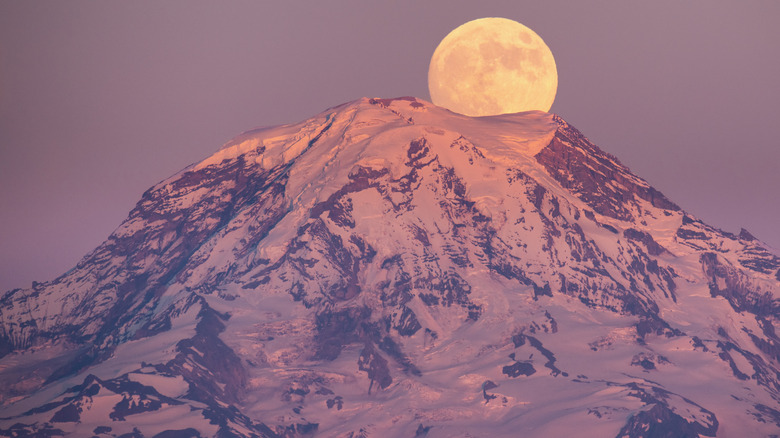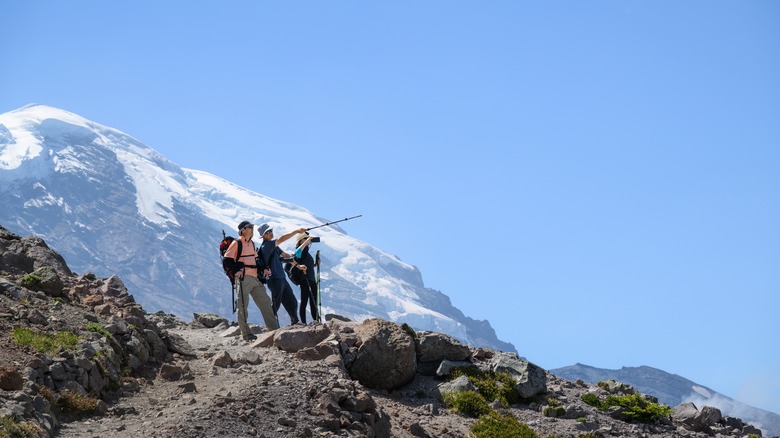Is This Major West Coast Volcano About To Erupt? Here's What Seismologists Say
Mount Rainier is known as the Crown of the Pacific Northwest, with good reason. This ice-covered jewel of Washington's Cascade Mountain Range is the tallest peak in the Cascades and draws visitors to its voluminous waterfalls and rewarding, scenic hikes. But it's technically an active volcano, and though it hasn't significantly erupted for an estimated 500 to 600 years, it's constantly monitored for seismic activity. On July 8, 2025, locals started wondering if the long-dormant volcano may be ready to erupt. A series of earthquakes began occurring in rapid succession, a phenomenon called an "earthquake swarm." The U.S. Geological Survey (USGS) reported hundreds of tremors – several quakes per minute – lasting over 12 hours. They ranged from 1.2 miles to 3.7 miles deep, peaked at 26 earthquakes per hour, and have exceeded 400 total as of this writing. The largest thus far is a magnitude 2.4, but they've all been so deep that people haven't felt them. Yet this activity begs the question: Is Mount Rainier about to erupt?
On July 8, the USGS posted a statement: "Currently, there is no indication that the level of earthquake activity is cause for concern, and the alert level and color code for Mount Rainier remain at GREEN/NORMAL." The agency also confirmed there had been no detectable changes to the surrounding ground. By July 11, the earthquake rate had lessened, but monitoring continues as quakes are expected to continue.
Seismologists say there's no immediate cause for alarm. In a statement (via NewsRadio 560 KPQ), the USGS attributed the tremors to "hydrothermal fluids that are interacting with pre-existing faults at shallow levels below the summit of the volcano." Essentially, ultra-hot groundwater and gas moved around pre-existing fault lines, which set off earthquakes. The USGS considers this "normal background levels of activity" for Mount Rainier, only worrisome if those earthquakes move up toward the surface of the earth.
What does this increased seismic activity really mean for Mount Rainier?
The USGS calls Mount Rainier "the most dangerous volcano" in the Cascades, citing its thick glacial covering — it holds the most glaciers of the lower 48 states – as well as its history of activity and proximity to high-population areas. Though it's not the only volcano in the region, which also includes Mount St. Helens and Mount Shasta, it poses the biggest threat. In fact, Rainier ranks No. 2 on the International Association of Volcanology and Chemistry of the Earth's Interior's "Decade Volcanoes" list, which identifies high-risk volcanoes for close monitoring. Italy's Mount Vesuvius, one of Europe's largest volcanoes — and most notorious — is ranked No. 1.
Rainier's recorded earthquake swarm on July 8 is the largest since 1982, when the USGS started monitoring it. Nine earthquakes are usually recorded at Mount Rainier each month, with a small swarm once or twice per year. The previous record was set in 2009, when over a thousand earthquakes occurred over the span of three days.
Scientists monitoring Rainier say the mountain's past movements may have caused "lahars" — rapid, ultra-hot mudflows — that collect debris and avalanche themselves down the volcano. The volcano's last catastrophic event, known as the Electron Mudflow, occurred more than 500 years ago. Its volcanic sludge was nearly 100 feet deep and spread as far as 60 miles away, though there is inconclusive evidence that an eruption caused this. The last Rainier eruption that had significant geological impact was over 1,000 years ago. Despite its long dormancy, experts worry about Rainier's proximity to Tacoma and South Seattle, and all the towns and communities in between. An eruption or even a major lahar could be catastrophic. For now, however, you can rest easy: The sleeping giant is only snoring.

